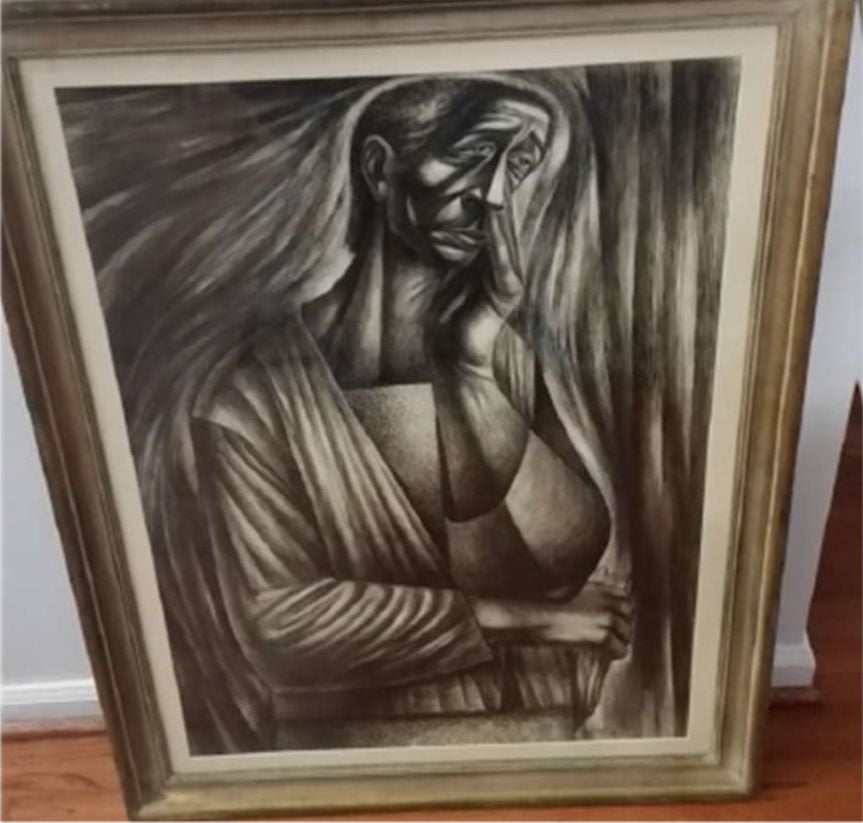
Howard University in Washington, DC, is suing for the return of a drawing by African American artist Charles White that turned up at Sotheby’s New York after having vanished from the school in the early-to-mid-1970s.
A South Carolina couple, Larry and Virginia Borders, consigned the Centralia Madonna to Sotheby’s earlier this year. It was expected to fetch $300,000–500,000 in the June 26 “American Art” sale. But trouble began when the auction house researched the ink, pencil, and gouache drawing, which depicts a Black Madonna tenderly touching her face, and found that the piece’s last documented owner was Howard University.
After Sotheby’s contacted Howard, the university responded claiming that it was the rightful owner of the piece, and demanded its immediate return from the Borders on June 17. The elite historically black university filed suit in New York’s Southern District just two days later, reports Bloomberg Quint.
The lawsuit comes as prices for White’s work have risen precipitously in recent years, on the heels of a traveling retrospective organized by the Art Institute of Chicago and New York’s Museum of Modern Art in collaboration with the Los Angeles County Museum of Art in 2018. (The MoMA presentation featured two works on loan from Howard.) White’s work broke the $1 million mark at auction—twice in one week—last fall; his pen-and-ink drawings are among his most coveted works.
The Centralia Madonna‘s current owners insist they had no ill intent. “The Borders are an elderly African-American couple that has lived with, and loved, the Charles White artwork for nearly all of the almost 50 years of their marriage,” the couple’s lawyer, Paul Cossu, told Artnet News. He claims that the couple was looking to resolve the dispute when Howard rushed to file a lawsuit based on “speculation” and “slanderous inferences.”
Sotheby’s, for its part, has withdrawn the work from the sale. “This is an ownership dispute between the university and the consignors, which follows Sotheby’s due diligence in researching the work’s provenance,” Sotheby’s told the New York Post. “Sotheby’s is merely a third-party stakeholder and will comply with any decision of the court.”
Howard’s lawyer, Peter C. Harvey of New York’s Patterson Belknap Webb & Tyler, did not respond to inquiries from Artnet News.
The school purchased the work in 1947 from the Barnett-Aden Gallery in Washington, DC, for the Howard University Gallery of Art, founded in 1928. The record of the drawing’s acquisition is noted in the university’s annual report, and was documented by local press at the time.
White was an artist-in-residence at the college in 1945, and Centralia Madonna is one of several of his works in the university art collection. Howard “was an early supporter of White’s work and a natural partner in his efforts to fight systemic racial injustice by empowering African Americans,” notes the complaint.
The university last saw Centralia Madonna between January 1973 and July 1974, when Scott Baker, now the gallery’s assistant director, documented the work for his master’s thesis, a catalogue of the university’s art collection. By 1976, an inventory listed the drawing’s whereabouts as unknown, even though there were no recorded loans of the work at that time, and the university has never deaccessioned any of its artworks.
The Borders claim that they received the piece as a gift from a close family friend, J.D. Kibler. According to the complaint, the couple has no documentation of how Kibler purchased the work, and was not able to recall what J.D. stood for or what he did for a living. When confronted by Howard on a phone call with Sotheby’s, the Borders “claimed that in fact they did not receive the work as a wedding gift [in 1972] but rather as a gift from J.D. Kibler for no particular reason.”
On the call, the couple “corrected the university’s lawyer’s misapprehension that the artwork was a wedding gift because it was not. The Borders have never changed that story,” Cossu countered, adding that “understandably after so many decades, they cannot reliably recall the precise month or even year” of the gift.
This resurgence of interest in White’s work saw the artist notch a new auction record last November, with two new highs on successive nights—Banner for Willie J on November 13 at Christie’s New York for $1.22 million and Ye Shall Inherit the Earth on November 14 at Sotheby’s New York for $1.76 million. According to the Artnet Price Database, White’s top four sales at auction are all from 2018 or 2019, but those are the only two above $509,000.
UPDATE: On Monday, the Borders struck back at Howard with a counterclaim claiming the university had unduly damaged their reputation and damaged the work’s prospects at auction with its “false allegations.” The couple claimed the university could not have proper title to the work because it waited so long to stake a claim and that there is no evidence its interest “is superior to the Borders” or “that the Borders have been dishonest.” They are asking for at least $100,000 in damages.